Results 7,171 to 7,180 of 12091
Thread: Anandtech News
-
07-20-17, 11:17 AM #7171
Anandtech: ASUS Introduces ROG Crosshair VI Extreme AM4 Motherboard for Ryzen
Most enthusiasts are familiar with ASUS’ Republic of Gamers (ROG) sub-brand bringing users what they state is an innovative lineup of products, promoted for performance and quality with gaming in mind. The ROG lineup has motherboards, graphic cards, laptops, desktops, monitors, even audio equipment, routers, and other peripherals. Today ASUS has announced in the US an addition to the AMD ROG family, the Crosshair VI Extreme Motherboard (C6E). The C6E is made on the AM4 platform using the flagship X370 chipset. According to ASUS, “...the ROG Crosshair VI Extreme is designed for gamers and power users looking to maximize AMD Ryzen performance”.
ASUS mentions ROG engineers worked on the board’s intelligent auto-tuner to improve one-click overclocking. For those new to overclocking, this means less hassle than manually tweaking multiple parameters to find a balance between a high overclock and having a stable system. Just click once, and the board should find a stable overclock. If one-click overclocking isn’t in the cards, and pushing the limits is the goal, the 12-phase VRM and plethora of overclocking features (dual bios, slow mode, LN2 mode, and voltage read points, to name a few) are also present.
Cooling an overclocked PC is an important factor as to how far one can safely push their machine. ASUS has partnered with Bitspower to produce a monoblock custom made for the Extreme (sold separately). The C6E uses a header on the board to monitor the Bitspower monoblock temperatures, flow rates, and also includes leak detection circuits. The board has other onboard connectors for keeping tabs on liquid temperatures and water flow at other points in the loop for users with their own thermistors. This data is managed by the FanXpert 4 software allowing consumers the ability to finely tune their cooling setup for performance, or silence as needed, across a total of 13 fan headers.
The Crosshair VI Extreme has the two full-length PCIe slots from the CPU using the ASUS Safeslot, which reinforces the PCIe bracket with a metal bracing for rigidity protection. With a nod to cooling, the dual full-length PCIe slots are spaced 3-slots apart giving two-slot coolers breathing room than with slots closer together. There is a third full-length slot on the board supporting a PCIe 3.0 x4 connection via the chipset which buyers can use for three-way CrossfireX using dual-slot video cards.
Looking at connectivity, the C6E has two USB 3.1 Gen2 (10 Gbps) ports on the rear, one Type-C and one Type-A, both from the chipset. It also has integrated Intel I211-AT gigabit Ethernet and an Intel AC 8265 as the 802.11ac module using a 2x2 antenna for Wi-Fi duties, as well as Bluetooth 4.1. There are a total of two M.2 ports - one uses the PCH/M.2 heatsink, and another which does not. For SATA, we see a total of eight ports. The back I/O plate is integrated and gives the board a clean look without having to install the I/O plate.
The C6E is using their latest SupremeFX banding, with an S1220 codec (based off the Realtek ALC1220) onboard audio. The actual IC is covered and protected from electromagnetic interference by the extended IO cover. The system contains an ESS Sabre DAC and “the usual assortment of engineering tweaks to improve the output and recording quality”, according to ASUS.
ASUS chose to use a monochromatic palette with a base color of black for the PCB with some stenciled in gray patterns, black and gray on the four DIMM slots, while the VRM cooling is mostly gray with some black highlights on it. The C6E will use its onboard LEDs (found on the I/O shroud, PCH, PCIe retention clips, and the right side of the board) and AURA Sync software to control the LEDs. If that isn’t enough, there is a header for addressable light strips allowing users to control each individual LED on the strip for even more lighting options. There are also two other onboard headers for standard LED strips. Another design feature aimed at aesthetics and overclockers is the right-angled 24-Pin ATX power connector. This change from vertical to lay flat against the board is said to allow for better cable routing in cases that have sufficient horizontal space.
Gallery: ASUS Crosshair VI Extreme



The flagship ROG Crosshair VI Extreme can be found on store shelves starting in early August with an MSRP of $349.
Related Reading:- The AMD Zen and Ryzen 7 Review: A Deep Dive on 1800X, 1700X, and 1700
- The AMD Ryzen 5 1600X vs Core i5 Review: Twelve Threads vs Four at $250
- AMD Announces X370 Motherboards for AM4: Laying the Groundwork for Ryzen
More...
-
07-20-17, 01:05 PM #7172
Anandtech: Alphacool Releases Two New SSD Coolers: Passive HDX-2 and Watercooled HDX-
This week Alphacool announced the availability of their new M.2 SSD Coolers, the HDX-2 and HDX-3. Some may recall the original HDX M.2 cooler was a simple, passive, clip on heatsink for M.2 SSDs, and was designed to help prevent thermal throttling which has a tendency to plague synthetic test results on some M.2 based drives. With the advent of the HDX-2 and HDX-3, they have moved beyond the simple clip cooler and to using a PCIe x4 card. This design change allowed a full sized heatsink to be mounted on it giving more surface area to cool the attached M.2 device. The HDX-3 takes the HDX-2 and its passive setup a step further and uses a waterblock instead of the large heatsink to remove the heat created from these SSDs.
The dimensions both the of HDX-2 come in at 100 x 81.5 x 20 mm with the HDX-3 being slightly taller at 120 mm while sharing the same width and height. According to Alphacool, the included 4x PCIe card allows a maximum bandwidth of around 3900 MB/s. Existing M.2 drives on the market will not be able to saturate it. Though it is double sided, both M.2 coolers hold one M.2 based device. Contact from the M.2 device to the heatsink is provided by included thermal pads. These thermals pads cover both single and double sided M.2 drives. The HDX-2 and HDX-3 both support up to one 80mm M.2 SSD. Both devices connect to the PCIe slot and mount to the case for a stable platform.
The HDX-2 uses large aluminum heatsinks on both sides of the included PCIe card easily covering the M.2 drive it aims to cool. The heatsinks are black with αCOOL and HDX-2 stenciled on it in white as well as having cooling fins to increase cooling area - the heatsinks cover the entire PCB of the PCIe card. The drive is mounted to the PCB, thermal pads applied to the drive, then mount the heatsink to the board.Alphacool HDX-2 and HDX-3 M.2 SSD Coolers Technical Data HDX-2 HDX-3 Dimensions (LxWxH) 100 x 81.5 x 20 mm 120 x 81.5 x 20 mm Material Aluminum Copper, Acetal Threads N/A 2x G 1/14" PCIe Form Factor PCIe 3.0 x4 Compatibility M.2 2280 PCIe SSDs Max. Bandwidth PCIe Card 3938 MB/s
The HDX-3 block is made of nickel-plated copper with the top made from a single piece of acetal. The block mounts to one side of the PCIe card leaving the other side open. Alphacool says water flows over the entire SSD to help keep things cool. The water enters and exits the block at the opposite end to the PCIe connector using standard G ¼” a threads.
Gallery: Alphacool HDX-2 and HDX-3





Pricing and availability were not listed in the press release.
Related Reading- Alphacool NexXxos Cool Answer 360 DDC/XT Liquid Cooling Kit Review
- The Alphacool Eisbaer 240 CPU AIO Liquid Cooler Review
More...
-
07-20-17, 03:18 PM #7173
Anandtech: ADATA Launches ISSS314 and IM2P3388 Industrial SSDs: 3D NAND, Extreme Temp
ADATA has introduced two new families of 3D NAND-based SSDs aimed at industrial applications. Dubbed the ISSS314 and the IM2P3388, these drives are designed to handle extreme temperatures as well as humidity levels, allowing them to work reliably in very tough environmental conditions. The more powerful IM2P3388 drives use a PCIe interface and offer high performance levels along with a powerful ECC engine and encryption, whereas the less speedy ISSS314 uses a SATA interface and offers very low power consumption that barely tops 2.5 W.
The IM2P3388: M.2, High Performance, Extreme Temps, Encryption, TCG Opal
The ADATA IM2P3388 is an M.2 drive that uses a NVMe PCIe 3.0 x4 interface and is based on 3D MLC NAND. This specific drive is designed to withstand ESD and EMI, up to 20 G vibration and 1500G/0.5ms shock, extreme temperatures from –40°C to +90°C, as well as high humidity (5%-95% RH, non-condensing). To put it into perspective: the IM2P3388 drives can operate in Antarctica or in the Lut Desert in Iran. In the real world, ADATA’s new SSDs will serve inside space-constrained industrial or commercial PCs, servers, military-grade systems, and embedded computers.
The IM2P3388 drives are based on a Silicon Motion controller that ADATA does not name, we suspect is the SM2260 with some additional customization. As for the NAND, the IM2P3388 SSDs use carefully selected 3D MLC that can handle high temperatures for prolonged amounts of time. The IM2P3388 takes advantage of all the capabilities of the controller and therefore supports AES-256 encryption, TCG Opal 2.0 spec, end-to-end data protection, and so on. In addition, the drive has multiple sensors that monitor its condition.
As for performance, ADATA specifies the drive to offer up to 2.5 GB/s sequential read speeds and up to 1.1 GB/s sequential write speeds (when pSLC caching is used), but does not specify random performance. ADATA’s IM2P3388 will be available in 128 GB, 256 GB, 512 GB, and 1 TB configurations. Keeping in mind the high density of modern flash chips, expect the entry-level models to be slower than their higher-capacity counterparts. In general, expect performance of the IM2P3388 to be comparable to the XPG SX8000 drives featuring the SM2260 and 3D MLC.ADATA IM2P3388 SSD Specifications Capacity 128 GB 256 GB 512 GB 1 TB Model Number Commercial IM2P3388-128GB IM2P3388-256GB IM2P3388-512GB IM2P3388-001TB Industrial IM2P3388-128GC IM2P3388-256GC IM2P3388-512GC IM2P3388-001TC Controller Silicon Motion SM2260 (?) NAND Flash 3D MLC NAND Form-Factor, Interface M.2-2280, PCIe 3.0 x4, NVMe 1.2 Operating Temperature Commercial -10°C to 80°C Industrial -40°C to C to 90°C Vibration Resistance 20G (10 - 2000 Hz) Shock Resistance 1500G/0.5 ms half sine wave Operating Humidity 5% - 95% RH non-condensing Sequential Read ~1000 MB/s (?) ~2000 MB/s (?) 2500 MB/s Sequential Write ~300 MB/s (?) ~600 MB/s (?) 1100 MB/s Random Read IOPS unknown Random Write IOPS unknown Pseudo-SLC Caching Supported DRAM Buffer Yes, capacity unknown TCG Opal Encryption Yes Power Consumption Up to 4.8W Power Management DevSleep, Slumber Warranty unknown MTBF >2,000,000 hours
The ISSS314: 2.5”, Extreme Temps, Low Power, Starting at 32 GB
The ADATA ISSS314 SSDs come in a traditional 2.5”/7 mm drive form-factor and use a SATA 6 Gbps interface. In order to satisfy the diverse needs of customers, ADATA will offer the ISSS314 in 32 GB, 64 GB, 128 GB, 256 GB, and 512 GB configurations. The higher-end models will provide up to 560 MB/s sequential read and up to 520 MB/s sequential write speeds, whereas the entry-level drives will be considerably slower. As for power consumption, the new SSDs are rated to only use up to 2.5 W, which puts them into the energy efficient category.
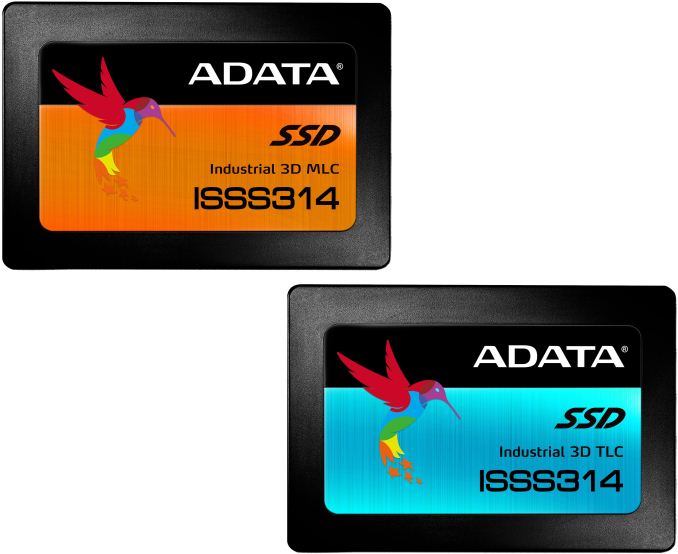
The ISSS314 SSDs are based on an unknown controller as well as 3D MLC and 3D TLC NAND memory sorted using ADATA’s proprietary A+ testing methodology to find the higher quality chips. The industrial ISSS314 drives based on 3D MLC memory are rated to withstand shock, EMI, and extreme temperatures from –40°C to +85°C, and thus are aimed at industrial applications. By contrast, commercial 3D MLC ISSS314 SSDs are rated for –10°C to +80°C operation. Meanwhile, the 3D TLC-powered ISSS314 is guaranteed to work in a temperature range from 0°C to +70°C, but can also withstand shocks, ESD, EMI, and so on. As for features, all the ISS314 SSDs have S.M.A.R.T, a temperature sensor, hardware power detection, and flash protection.
ADATA does not publish recommended prices for its industrial and commercial SSDs. Since such products rarely show up in mainstream retail, their actual prices for customers typically fluctuate depending on the order size and other factors.ADATA ISSS314 Specifications Capacity 32 GB 64 GB 128 GB 256 GB 512 GB Model Number MLC Commercial ISSS314-032GB ISSS314-064GB ISSS314-128GB ISSS314-256GB ISSS314-512GB Industrial ISSS314-032GC ISSS314-064GC ISSS314-128GC ISSS314-256GC ISSS314-512GC TLC Commercial - ISSS314-128GD ISSS314-256GD ISSS314-512GD Controller Silicon Motion SM2258 (?) Form-Factor/Interface 2.5"/7 mm/SATA NAND MLC Commercial 3D MLC Industrial 3D MLC TLC Commercial - 3D TLC Operating Temp. MLC Commercial -10°C to 80°C Industrial -40°C to C to 85°C TLC Commercial 0°C to 70°C Vibration Resistance 20G (10 - 2000 Hz) Shock Resistance 1500G/0.5 ms half sine wave Operating Humidity 5% - 95% RH non-condensing Sequential Read unknown 560 MB/s Sequential Write unknown 520 MB/s Random Read IOPS Up to 90K IOPS (taken from SM2258, actual will be lower) Random Write IOPS Up to 80K IOPS (taken from SM2258, actual will be lower) Pseudo-SLC Caching Supported DRAM Buffer Yes, capacity unknown TCG Opal Encryption No Power Consumption Up to 2.5W Power Management DevSleep Warranty unknown MTBF 2,000,000 hours
Related Reading:
- Transcend Introduces Extreme Temperature DDR4 SO-DIMMs
- Logic Supply ML100G-50 Fanless Skylake vPro Industrial NUC Review
- ADATA Launches XPG SX8000: High-End M.2 NVMe SSD Featuring 3D MLC NAND
- ADATA Announces XPG Gammix S10: 3D TLC, SM2260, 1.7 GB/s Seq. Read, Radiator
- ADATA Announces The XPG SX7000 Series SSDs: Up to 1 TB, M.2, PCIe 3.0 x4
- Previewing Silicon Motion SM2260 NVMe Controller With 3D MLC NAND (512GB)
- ADATA Announces Ultimate SU900: 3D MLC NAND, SMI Controller, SATA
- ADATA Introduces Ultimate SU800 SSD: SMI Controller, 3D NAND, SATA Interface
More...
-
07-21-17, 09:47 AM #7174
Anandtech: MAINGEAR Launches R2 Razer Edition: Mini-ITX System with AMD Ryzen or Inte
MAINGEAR this week introduced the first small form-factor Razer Edition desktop aimed at loyal clients of Razer. The new MAINGEAR R2 Razer Edition uses AMD’s and Intel’s latest platforms and comes with a lot of green lights, green coolant, and other green features to reflect the company’s main color.
Razer has made quite a name for itself over the years in the gaming laptop market, but instead of entering the desktop business, the company decided to collaborate with renowned system builders to produce "Razer Edition" PCs. This enables Razer to offer Razer-branded desktops customers without entering a highly competitive market, whereas its partners gain access to Razer’s customer base. So far, Razer has collaborated with Lenovo and MAINGEAR for tower gaming desktops aiming mainstream and no-compromise gamers. With the MAINGEAR R2 Razer Edition, the two companies offer something for those who are looking for a miniature system featuring extreme components with further overclocking potential and liquid cooling.
The MAINGEAR R2 Razer Edition is a Mini-ITX desktop that can fit in a motherboard based on AMD’s B350 or Intel’s Z270 chipset as well as an AMD Ryzen R5/R7 or Intel Core i5/i7 CPU respectively. Keeping the form-factor in mind, the R2 Razer desktop can fit in one graphics card (up to NVIDIA’s Titan Xp), one 3.5” or two 2.5” storage devices, as well as one M.2 PCIe 3.0 x4 NVMe SSD. Unlike many contemporary gaming desktops, the MAINGEAR R2 can accommodate a 5.25” ODD, and when equipped with an appropriate drive, can playback Blu-ray disks.
When it comes to the motherboard choice, MAINGEAR offers ASRock AB350 Gaming-ITX/ac for use with AMD's Ryzen processors or ASUS ROG Strix Z270I Gaming or MSI Z270I Gaming Pro Carbon AC for Intel’s Core i7 CPUs. All of the motherboards feature GbE, 802.11ac Wi-Fi, Bluetooth 4.2, 7.1-channel audio, as well as USB 3.1 connectivity. MAINGEAR’s product brochure for the R2 also mentions ASRock’s X99 Mini-ITX motherboard, but at this point, it is impossible to order such a system, which is not surprising as this is an outgoing platform.

Cooling is crucially important for high performance gaming PCs and MAINGEAR offers many options for the R2 Razer Edition. For entry-level builds, MAINGEAR can install AMD’s or Intel’s retail CPU coolers and keep stock cooling systems on the GPU. For something more advanced, the company offers the closed loop EPIC 240 LCS for the CPU. For high-end configurations MAINGEAR can also build a custom open loop LCS for both the CPU and GPU featuring soft tubing and a 360 mm radiator, whereas for ultra-high-end builds the PC maker can design a custom LCS with crystal or metal hardline tubing, chrome fittings, and other stylish components.
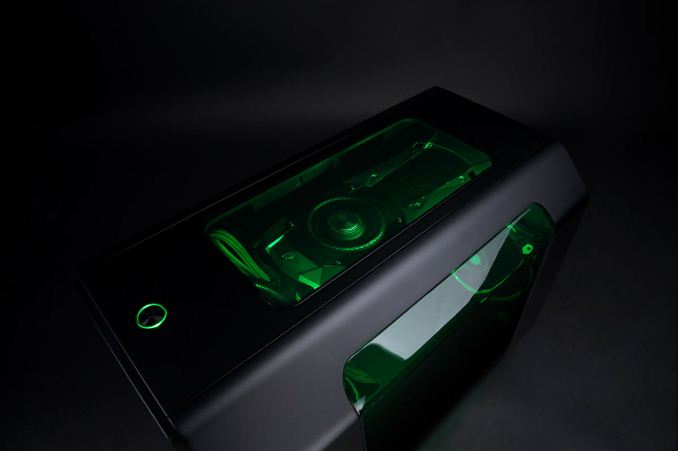
MAINGEAR’s R2 Razer Edition desktops are now available from the company’s web site. Entry-level machines featuring AMD's Ryzen R5 or Intel's Core i5 start at $1099 and $1199, respectively. Meanwhile, SuperStock configurations featuring a customized LCS with hardline tubing and top-of-the-range CPUs and GPUs start at $4299 or $4399 depending on the platform.
Gallery: MAINGEAR Launches R2 Razer Edition: Mini-ITX System with AMD Ryzen or Intel Core i7





Related Reading:
- HP and MAINGEAR Team Up for Omen X High-End Gaming PC
- MAINGEAR Rolls-Out 34” All-in-One PC with 18-Core Xeon, GeForce GTX Titan X
- Razer Files for IPO in Hong Kong to Raise $600 Million
- Razer Updates The Razer Blade Stealth: More Screen, Less Bezel, New Color Option
More...
-
07-21-17, 01:19 PM #7175
Anandtech: Dell’s UltraSharp U3818DW Now Available: Curved 37.5”, 3840×1600, USB-C, $
Dell this week began shipments of its curved ultra-wide 3840×1600 UltraSharp U3818DW display. The monitor is the fourth screen of this size and with this resolution on the market, and one of a few displays with a USB Type-C input (via DP 1.2 alternate mode). Dell is positioning its U3818DW as a business-class monitor, so it gets market-typical features such as an antiglare coating, but notably it does not get support for AMD’s FreeSync (which is available on competing monitors).
The Dell UltraSharp U3818DW is based on a 37.5” 8-bit + FRC IPS panel featuring a 3840×1600 resolution, a 24:10 aspect ratio, 2300R curvature, and 1.07 billion colors. This panel has rather unique specifications and comes from LG Display. So far, three displays have used the panel for monitors aimed at consumers. For example, LG’s own 38UC99 and Acer’s XR382CQK come with FreeSync support and up to 75 Hz refresh rate (LG’s one only supports 75 Hz when FreeSync is used). Moreover, ASUS’s Designo Curve MX38VQ has integrated wireless Qi charging, whereas the LG 38UC99 has Bluetooth speakers (to playback music from smartphones or notebooks without using wires), two consumer-oriented features. By contrast, Dell seems to position its UltraSharp U3818DW in a similar way that it positions a number of its other curved displays: as a solution for business users looking to do a lot of multi-tasking.
In a bid to better appeal to the target audience, Dell has managed to increase maximum brightness of its U3818DW to 350 nits (from 300 nits on competing monitors), added an antiglare coating, and also added support for Dell's Command remote management capability. Each screen is sRGB-calibrated to Delta E < 2 accuracy, which is important for those who work with color-managed content. Meanwhile, the monitor also technically supports the DCI-P3 color gamut, but only covers 78.1% of it.Dell UltraSharp U3818DW Panel 37.5" IPS Resolution 3840 × 1600 Refresh Rate 60 Hz Response Time 5 ms gray-to-gray Brightness 350 cd/m² Contrast 1000:1 (?) Viewing Angles 178°/178° horizontal/vertical Color Saturation 99% sRGB
78.1% DCI-P3Pixel Pitch ~0.23 mm Pixel Density 110 ppi Anti-Glare Coating Yes Inputs 1 × DisplayPort 1.2
2 × HDMI 2.0
1 × USB 3.0 Type-CUSB Hub 4 port USB 3.0 hub: four USB-A Audio 9 W × 2 Launch Price $1499.99
Dell’s formal positioning of the U3818DW does not really curtail its advantages for home users. Its resolution and the aspect ratio are well suited for displaying HD and UHD content filmed in an aspect ratio of 2.35:1 or 2.40:1 (a lot of movies are shot in such aspect ratios) as well as for games. Meanwhile, the monitor is equipped with HDCP 2.2, so it can display protected UHD content transfered to it using one DP 1.2 or two HDMI 2.0 inputs.
Dell’s UltraSharp U3118DW is now available directly from Dell for $1500, which is a bit lower than the price of LG’s 38UC99, but higher compared to similar displays from Acer (available now) and ASUS (set to be available in Q3).37.5” Curved Displays with 3840×1600 Resolution Model Acer
XR382CQKASUS
MX38VQDell
U3818DWLG
38UC99Inputs 1×DisplayPort 1.2
1×mDP 1.2
1×HDMI 2.0
1 × MHL 1.2
1 × USB-C (alt mode DP1.2)1×DisplayPort 1.2
2×HDMI 2.01×DisplayPort 1.2
2×HDMI 2.0
1×USB-C (alt mode DP1.2)1×DisplayPort 1.2
2×HDMI 2.0Max. Refresh Rate 75 Hz unknown 60 Hz 60 Hz - 75 Hz with FS Dynamic Refresh Rate FreeSync unknown no FreeSync Audio 2×7W 2×8W Harman 2×9W 2×10W Bluetooth USB Hub 4-port USB-A 3.0 4-port USB-A 3.0
(2 upstream ports)3-port USB 3.0:
2×USB-A
1×USB-CSpecial Features - Qi charging (5W/1A) Antiglare coating
sRGB at Delta E- Approximate Price $1300 $1100 $1500 $1700
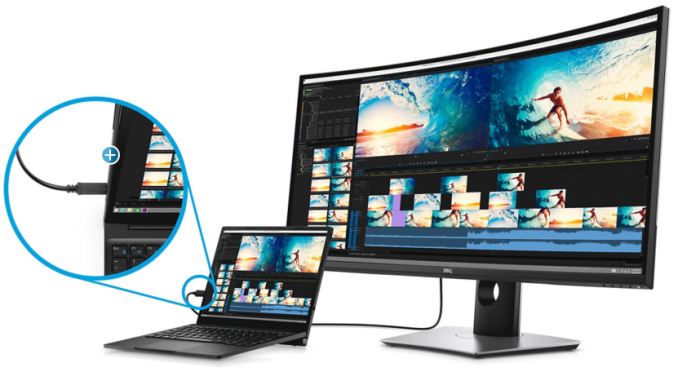
Related Reading:
- Acer Launches Curved XR382CQK Display: 37.5-inch, 3840×1600, FreeSync, & USB-C
- ASUS Announces Designo Curve MX38VQ: 37.5 Inch Curved Display with Qi Charging
- LG 38UC99 Announced: 37.5-Inch Curved 21:9 Display with 3840×1600 Resolution
More...
-
07-22-17, 10:54 AM #7176
Anandtech: BenQ Announces ZOWIE XL2546 ‘eSports’ Display: 24'', FHD, 240 Hz, DyAc ULM
BenQ this week introduced a new version of its ZOWIE XL2540 ultra-fast gaming display it launched last year. The improved device carrying the XL2546 model number has the same specifications as its predecessor, including a 1920×1080 resolution and a refresh rate as high as 240 Hz, but also adds BenQ’s proprietary DyAc (Dynamic Accuracy) technology designed to make fast-motion scenes a bit more clear.
The BenQ ZOWIE XL2540 monitor is one of the fastest gaming displays on the market today. The unit was launched in late 2016 and now BenQ launches its improved version, the ZOWIE XL2546 with DyAc. According to a preorder page at B&H, the new model mimics nearly the specs of the predecessor, then the new display features the same 24.5” TN panel from AU Optronics with a 1920×1080 resolution (it is the only 24" FHD panel with a 240 Hz refresh rate), supports for 16.7 million (6-bit + FRC) colors, has a typical contrast ratio for mainstream screens (1000:1), as well as offers a 320 cd/m2 brightness, which is lower compared to what the XL2540 offers (400 cd/m2). For some reason, with the ZOWIE XL2546, BenQ continues to ignore AMD’s FreeSync and NVIDIA’s G-Sync dynamic refresh rate technologies.
Two main features of the ZOWIE XL2546 display are its native 240 Hz refresh rate as well as the company’s DyAc (Dynamic Accuracy) technology that enhances the display's motion clarity. The manufacturer does not explain anything about this tech, but from various media reports (e.g., this one) it appears that the DyAc is BenQ's implementation of Ultra Low Motion Blur backlight strobing. ULMB reduces motion blur by inserting a black image between each frame of video and thus reducing time each frame is displayed. Given the hardware similarities between the monitors, I'm left to ponder of BenQ could have enabled this in current monitors via a firmware update, but for some reason BenQ decided not to add it to the ZOWIE XL2540, but to launch a new display instead.
Other interesting capabilities of the ZOWIE XL2540/XL2546 are the Black eQualizer that increases the brightness of dark areas without oversaturating the bright areas, an option to quickly increase color vibrancies, a special external controller to activate different settings and profiles rapidly, as well as a light-shielding hood (which BenQ calls a way to help gamers to focus on their games).
Just like the XL2540, the XL2546 uses DisplayPort 1.2, HDMI, and DVI-DL to connect to host PCs (though it should be noted that DVI does not support a 240 Hz refresh rate). In addition, the monitor has an integrated three-port USB hub and a PSU.
BenQ plans to showcase the ZOWIE XL2546 display at DreamHack Atlanta 2017 this weekend. The company does not disclose anything regarding the price or the ETA of the new unit officially, but B&H is charging $549 for the new unit, which is $50 higher compared to its predecessor.
Related Reading:
- BenQ Announces the ZOWIE XL2540: 24-Inch 240 Hz Full-HD Display 'for e-Sports'
- BenQ PD2710QC Announced: 27" 2560x1440 with Integrated USB Type-C Dock
- BenQ Launches the SW320: a 4K Display with HDR for Professionals
- Samsung Announces First Freesync 2 Monitors: CHG70 & CHG90 - Quantum Dots, Up to 49”, 144 Hz, DCI-P3
- Acer Predator X35 & ASUS ROG Swift PG35VQ Unveiled: 35-inch G-SYNC HDR Monitors - UltraWide, Curved, 200Hz
- AOC Launches the AG352QCX: 35-Inch 200 Hz 2560×1080 Curved Display with Adaptive-Sync
- Acer Predator Z35P Available for Order: Curved 35" with 3440×1440@120 Hz and G-Sync
- Acer Predator Z271UV Gaming Monitor: 1440p, 144-165Hz, G-Sync, Eye Tracking
More...
-
07-24-17, 08:24 AM #7177
Anandtech: The Intel Kaby Lake-X i7 7740X and i5 7640X Review: The New Single-Threade
Intel’s direction for the high-end desktop space has taken an interesting turn. After several years of iterative updates, slowly increasing core counts and increasing IPC, we have gotten used to being at least one generation of microarchitecture behind the mainstream consumer processor families. There are many reasons for this, including enterprise requirements for long support platforms as well as enterprise update cycles. For 2017, Intel is steering the ship in a slightly different direction, and launching the latest microarchitecture on the HEDT platform. These CPUs don’t feature the high core counts of the other HEDT parts, but offer a higher point up the voltage/frequency scale to be the fastest single thread processors money can buy. They also overclock quite well.
More...
-
07-24-17, 10:10 PM #7178
Anandtech: NVIDIA Releases 384.94 WHQL Game Ready Driver: ShadowPlay Highlights for L
Following up on the July 4th 384.80 hotfix resolving Watch Dogs 2 crashing on startup, today NVIDIA has released driver version 384.94, an update heavily focused on game support. Along with the usual bugfixes, this edition brings Game Ready support for several titles: LawBreakers, ARK: Survival Evolved, Dark and Light, Fortnite Early Access, and Hellblade: Senua’s Sacrifice. This release also sees the official debut of ShadowPlay Highlights via LawBreakers, as well as support for EVE: Valkyrie’s new Ultra graphics settings.
Building off of support for the LawBreakers “Rise Up” Open Beta in 384.76, NVIDIA has followed up with driver support for the full release of LawBreakers, slated for release on August 8th. The upcoming release also brings the first game to support NVIDIA’s new ShadowPlay Highlights feature, a GameWorks technology.
Presently, LawBreakers is also the only game with ShadowPlay Highlights support, and NVIDIA has posted a guide describing how ShadowPlay Highlights works for matches in LawBreakers. ShadowPlay Highlights requires GeForce Experience, and automatically captures gameplay video and screenshots, allowing for easier sharing and uploading.
Under the hood, the game's developers configure what events and actions automatically trigger recording by ShadowPlay Highlights. While these triggers are game-specific, examples include multi-kills, boss battles, and unlocking achievements. After a session, the Highlights can be selected to be shared via Facebook or YouTube. Imgur uploading support is mentioned but does not specifically appear for LawBreakers at this time.
Moving on, 384.94 brings Game Ready VR support for EVE: Valkyrie’s “Ultra” graphics settings, which developer CCP Games worked with NVIDIA to create. Among the new settings are volumetric lighting (“God Rays”), Multi-Sample G-Buffer Anti-Aliasing (MSGAA), and Lens Matched Shading (LMS). The last feature, LMS, actually involves rendering to the curvature and shape of VR headset lenses; because a rectangular render has extra unneeded pixels for a curved lens, this can increase performance.
In addition to Game Ready support for ARK: Survival Evolved, Dark and Light, Fortnite Early Access, and Hellblade: Senua’s Sacrifice, NVIDIA has also brought Ansel support for ARK: Survival Evolved and Dark and Light. We’ve described Ansel before, but as a quick summary it is NVIDIA’s ultra-high resolution screenshot utility with an artistic flair, able to capture 360 degree 3D images.
In terms of gamefixes, an SLI issue with GeForce GTX 980s in IL-2 Sturmovik: Battle for Stalingrad was resolved, where performance was not improved under DX11 after enabling SLI. A game-crashing bug within minutes of gameplay was also fixed in Star Ruler 2, as was freezing in Gears of War 4 with the GTX 970 and poor GeForce performance in DNF. HDR settings can now be enabled from the in-game Mass Effect: Andromeda menu while running in full-screen mode on a Titan Xp. Similarly, color over-saturation no longer occurs in Shadow Warrior 2 with GTX 1070/1080 due to Windows HDR conflicting with in-game HDR settings. Lastly, NieR:Automata no longer freezes with the GTX 780/780 Ti, and Watch Dogs 2 no longer crashes on launch with the Titan X.
On the non-game side of matters, an issue was resolved where Channel 9 and rPlay apps on the Windows Store became choppy during playback before crashing. In addition, a DisplayPort connection issue was fixed where the monitor would display no signal after a power cycle on the GTX 980.
Wrapping things up, NVIDIA has also added or updated SLI profiles for LawBreakers and ARK: Survival Evolved, as well as IL-2 Sturmovik: Battle of Stalingrad. Finally, NVIDIA is offering a promotional Mass Effect: Andromeda giveaway to selected GeForce Experience users. Users are made eligible by simply logging into GeForce Experience, and then opting into communications from NVIDIA. Winners will be informed via GeForce Experience notification on August 1st. This promotion is not available in China.
The updated drivers are available through the GeForce Experience Drivers tab or online at the NVIDIA driver download page. More information on this update and further issues can be found in the 384.94 release notes.
More...
-
07-25-17, 08:02 AM #7179
Anandtech: Western Digital Announces Four Bit Per Cell 64-Layer 3D NAND Flash
Western Digital's SanDisk subsidiary and Toshiba have a long history of jointly developing and manufacturing NAND flash memory. While that relationship has been strained by Toshiba's recent financial troubles and attempts to sell of their share of the memory business, the companies are continuing to develop new flash memory technology and are still taking turns making new announcements. In recent months both companies have started sampling SSDs using their 64-layer BiCS3 TLC 3D NAND and have announced that their next generation BiCS4 3D NAND will be a 96-layer design.
Yesterday Western Digital made a small announcement about their other main strategy for increasing density: storing more bits per memory cell. Western Digital will introduce four bit per cell QLC parts built on their 64-layer BiCS3 process, with a capacity of 768Gb (96GB) per die. This is a substantial increase over the 512Gb BiCS3 TLC parts that will be hitting the market soon, and represents not only an increase in in bits stored per memory cell but an increase in the overall size of the memory array. These new 3D QLC NAND parts are clearly intended to offer the best price per GB that Western Digital can manage, but Western Digital claims performance will still be close to that of their 3D TLC NAND. Western Digital's announcement did not mention write endurance, but Toshiba's earlier announcement of 3D QLC NAND claimed endurance of 1000 program/erase cycles, far higher than industry expectations of 100-150 P/E cycles for 3D QLC and comparable to 3D TLC NAND.
Western Digital has not announced any specific products based on QLC NAND flash, but they will be exhibiting both removable media and SSDs using QLC NAND at Flash Memory Summit August 8-10. Western Digital's CTO will be delivering a keynote presentation at FMS on August 8, so more details are likely to be revealed in two weeks.
Western Digital's roadmaps also include plans for QLC parts on their 96-layer BiCS4 process, with capacities up to 1Tb (128GB) per die. BiCS4 production is scheduled to ramp up over 2018 and 2019 with the QLC parts expected to arrive later in the cycle, so Western Digital's first-generation 3D QLC based on the BiCS3 process will probably be their highest-density flash memory in mass production for over a year.
More...
-
07-25-17, 10:27 AM #7180
Anandtech: Bluetooth SIG Announces Bluetooth Mesh for Large-Scale Device Networks
The month the Bluetooth SIG has taken the wraps off of their latest standards project: an addition to the Bluetooth specification that enables creation of large networks of devices. Dubbed "Bluetooth Mesh", the new standard is designed for smart homes, public and manufacturing facilities. An extension of the Bluetooth LE protocol, the Bluetooth SIG hopes that the first products supporting the Bluetooth Mesh specification will be quickly available in the coming months as the new technology does not require principally new hardware.
Bluetooth Evolution
The Bluetooth technology was originally developed in the late 1990s to enable wireless device-to-device communications. This device-to-device tech has been evolving since 1997 by improving transfer rates, extending range, and improving reliability. In the early 2000s, researchers and product developers determined that there were many devices that could benefit from short-burst wireless connectivity, but did not need a fully-fledged Bluetooth implementation due to power consumption and size concerns. To this end, developers from Nokia and other companies started to design a low-power version of Bluetooth that was first marketed under the Wibree trademark in 2006 and then became a part of the Bluetooth 4.0 spec under the Bluetooth Smart (Bluetooth LE) trademark.
Bluetooth LE introduced a one-to-many communication paradigm to the standard, enabling various new usage models and applications, such as item finding beacons or way finding beacons. Meanwhile, device-to-device and device-to-many-devices Bluetooth interconnections ultimately use a star topology, and thus such networks have limits to their range and the number of devices in a network, which can inhibit their usage models.
With the introduction of the Bluetooth Mesh standard, the Bluetooth SIG is bringing a many-to-many communication paradigm to the standard. As the name implies, Bluetooth Mesh enables building large-scale device networks with a mesh topology and thus extends the range of a single Bluetooth network virtually to infinity (mind latency and other factors though). In turn, such large networks open up new usage models for the technology, particularly in the field of IoT devices.
How It Works
At a high level, Bluetooth Mesh uses the Bluetooth 4.0 LE protocol to transport data between devices (nodes). This means that from a data transmission point of view, nearly everything has already been specified, from low layer radios to encryption to application layers.
What Bluetooth Mesh adds on top of Bluetooth LE is an ability to retransmit data (a message) from one device to other devices that are in direct radio range (a single hop away) until it reaches the destination — the address it is sent to — using the so-called managed flooding technique. Managed flooding allows the receiver to determine how many hops it's away from the sender, and thus disable message relaying further than it is needed (i.e., set the maximum number of hops over which the message is retransmitted), thus preserving power and saving the bandwidth of the whole network. This technique ensures that the message always reaches its destination potentially using various paths even if certain nodes fail. Moreover, by not using routing devices, Bluetooth Mesh networks become cheaper and more reliable — messages always get to their destinations no matter what happens to individual nodes within a network (so long as there's a path).
Under the hood, Bluetooth Mesh networks consist of relay nodes that can retransmit messages, and low-power nodes that connect to relay nodes to periodically transmit or receive data using a mechanism called friendship (i.e., each LP node has a Friend). Low-power nodes could be various sensors or beacons that only use short-burst data transmissions with their “Friends”, which then retransmit their data to other nodes.
The Bluetooth SIG says that a single Bluetooth Mesh network can contain up to 32,767 elements (a node has at least one element, or addressable entity), but admits that in the real world such networks will typically consist of at most thousands, rather than tens of thousands of devices.
When it comes to bandwidth, the gross air data rate of the Bluetooth LE is 1 Mb/s (at maximum transmit power of 10 mW), but this figure does not account for protocol overhead. There are reports that the maximum achievable BLE data rate is around 10 KB/s depending on the devices used. Such data rates are not a problem for point-to-point communications within the contemporary star network topology. However what happens when hundreds of devices start passing numerous messages over the mesh network remains to be seen. Bandwidth, latency (6 ms per hop – the standard for the Bluetooth LE) and lack of priority attributes for data packets could be limiting factors for Bluetooth Mesh adoption in environments that generate loads of data.
It is important to note that the Bluetooth SIG made interoperability a part of the specification development process, and therefore thousands of interoperability tests have already been conducted. This is not exactly surprising as the Bluetooth Mesh spec builds up Bluetooth LE, and therefore existing Bluetooth 4/5-capable chips can support the new technology. Meanwhile, actual contemporary devices may or may not receive firmware and software upgrades to enable Bluetooth Mesh support. Some device makers interested in addressing smart home and other applications are more likely to enable the new spec on existing products, but others are more likely to qualify future products for the new tech.
Use Cases and Competition
At present, the Bluetooth SIG and its members are pursuing several key applications for Bluetooth Mesh: smart home, lighting, beaconing, automation, and asset tracking applications. For example, integrating relay-capable nodes into lighting devices across a home extends range of the network to the whole building. Each of the multiple relay nodes installed in every room can then connect to various low-power nodes, such as temperature sensors, thermostats, window blind controls, and so on. In a warehouse, a robot could navigate its way across the building without any network range-related constraints while enabling operators to track its whereabouts.
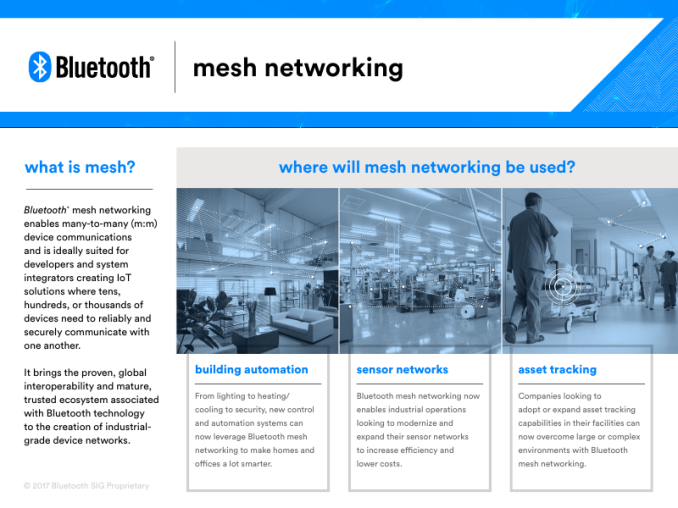
The Bluetooth SIG is certainly not alone with its mesh-networking standard for IoT applications, both in general and smart homes in particular. There is ZigBee that is used for various smart home appliances already, there are proprietary technologies, and Wi-Fi HaLow is incoming. A natural advantage that the Bluetooth SIG and its members have is that there are hundreds of millions of Bluetooth-enabled devices produced and sold every year, and therefore the majority of upcoming smartphones, smart TVs, notebooks, tablets, and other products will have the ability to be compatible with the Bluetooth Mesh specification. As a result, it will make a lot of sense for developers of smart home appliances to design devices compatible with Bluetooth Mesh — millions of consumers will have compatible devices in about a year from now, and this is a huge number for an emerging market. Meanwhile, when it comes to custom automation or industrial applications, it remains to be seen which technology developers prefer for their large-scale device networks.
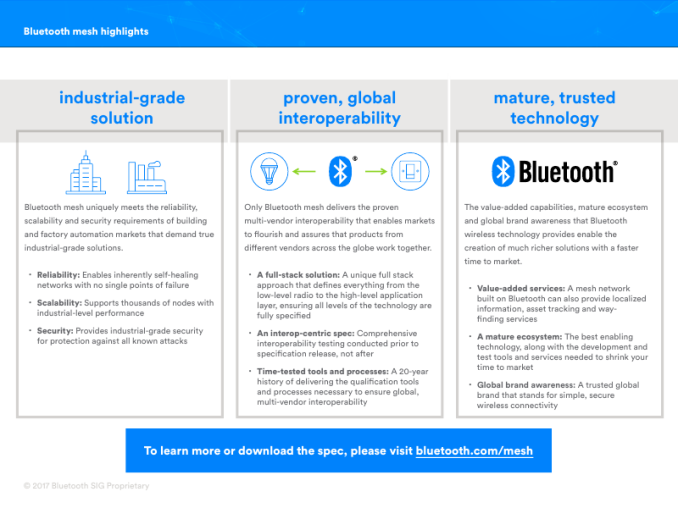
Preliminary Thoughts
Nowadays there are billions of Bluetooth LE-enabled devices, and in the coming years their number will grow further not only because people will buy more smartphones, but because a lot of brand new device types will emerge. The Bluetooth Mesh specification enables building large-scale device networks without the need to launch any new hardware, and thus makers of smart home appliances (and other devices) may begin quickly adopting the new tech in the coming months.
Relying on the Bluetooth LE specification and the managed flooding message transport technique ensures that Bluetooth Mesh-based large-scaled device networks will have predictable performance (RF interference withstanding), known security mechanisms, high reliability, and relatively low costs. Moreover, to a degree the usage Bluetooth LE eliminates the chicken and egg dilemma for the new standard early in its life, as supporting devices are already here. However, it is not completely clear how the number of nodes per single network affects its performance, and that will be a very important factor once large networks consisting of hundreds or thousands of nodes are built.
Keeping in mind that Bluetooth connectivity is ubiquitous nowadays, Bluetooth Mesh has a good chance to become a very popular wireless standard for smart homes and other applications, provided that it can deliver the right performance and ensure compatibility and interoperability between devices from different vendors. The Bluetooth SIG says that interoperability is nearly guaranteed for Bluetooth Mesh supporting devices, but we will have to see how that pans out ourselves.
Otherwise, while developers of smart devices can start building Bluetooth Mesh products based on silicon solutions designed by others, they will still have to complete the long-standing Bluetooth qualification and/or declaration processes in order to ensure that their products satisfy the Bluetooth license the requirements and to pay the appropriate fees. This is not going to be a problem for the established players, but may pose a small challenge for small startups.
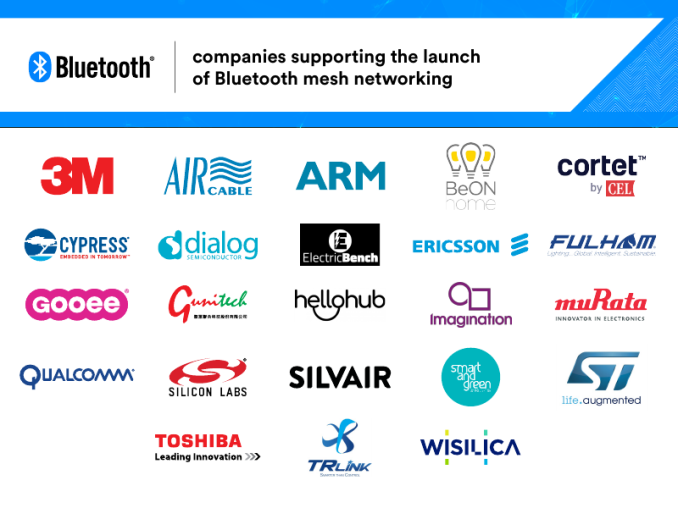
Finally, the Bluetooth SIG is naming a number of semiconductor manufacturers, software developers, and device manufacturers as among Bluetooth Mesh's early adopters. This include 3M, ARM, Ericsson, STMicroelectronics, Qualcomm, Toshiba, and others. While the organization does not announce any final products, it makes it clear that Bluetooth Mesh is has manufacturer support at both the silicon and on-device levels. Moreover, there are turnkey silicon and software solutions available from companies like Cypress, Silicon Labs, and Wisilica to build devices compatible with Bluetooth Mesh. Ultimately, the sky looks blue for the Bluetooth Mesh to take off, but its actual market acceptance will depend on the adoption of IoT devices for homes, offices, and production facilities.
More...
Thread Information
Users Browsing this Thread
There are currently 18 users browsing this thread. (0 members and 18 guests)




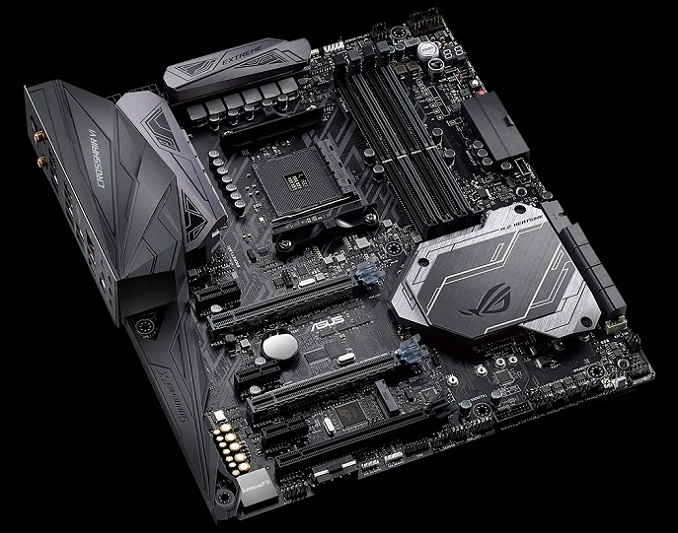

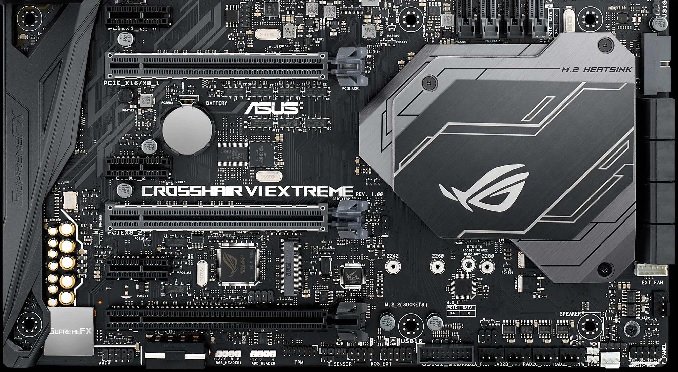

 Quote
Quote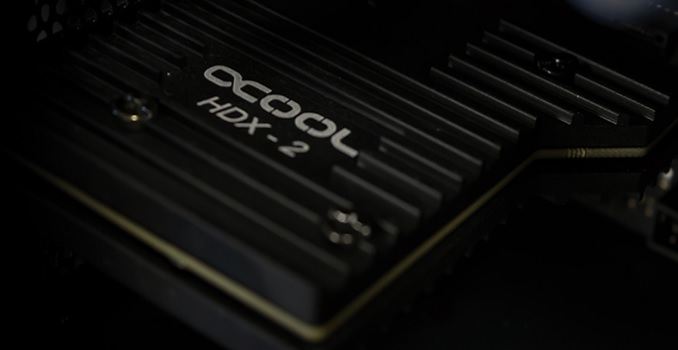

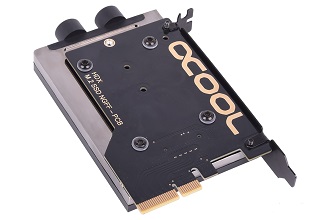
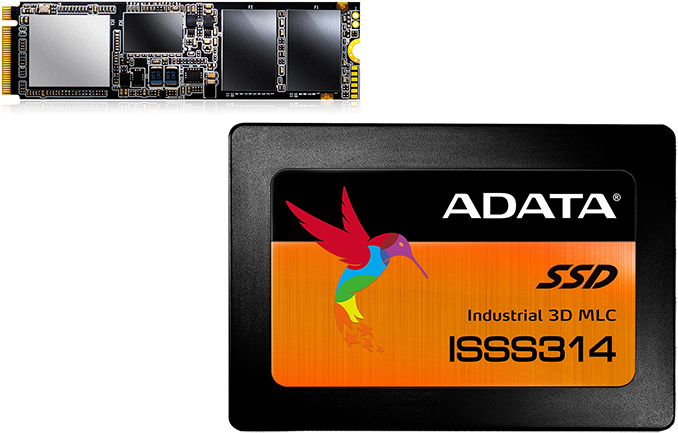

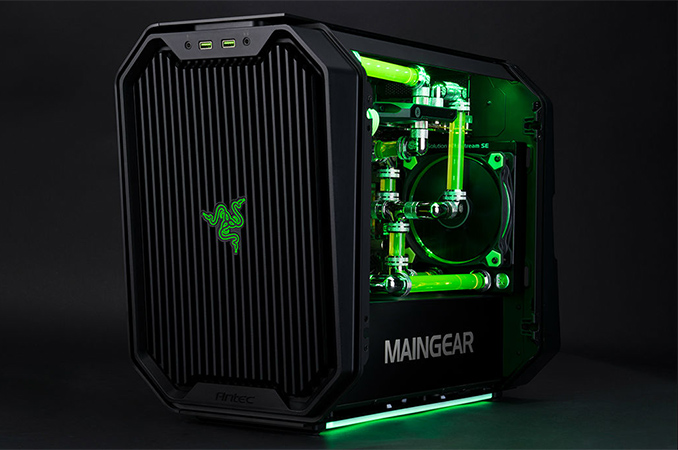

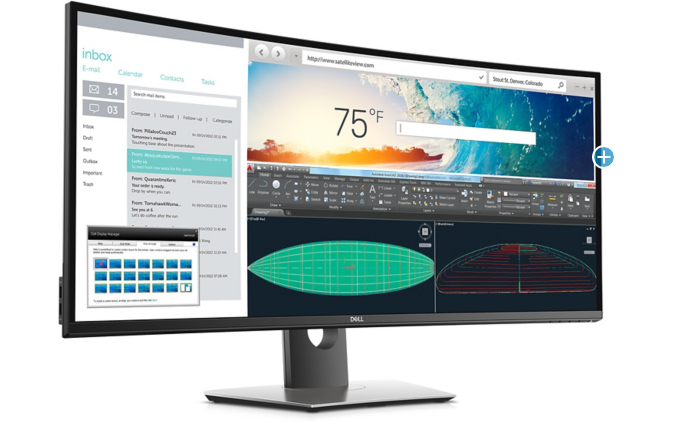
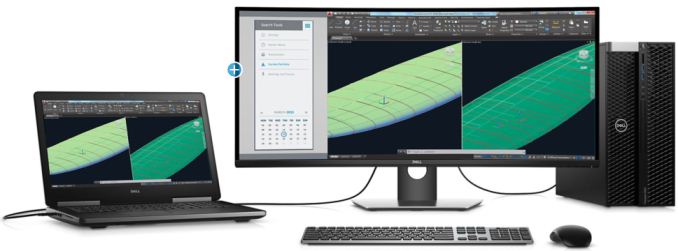
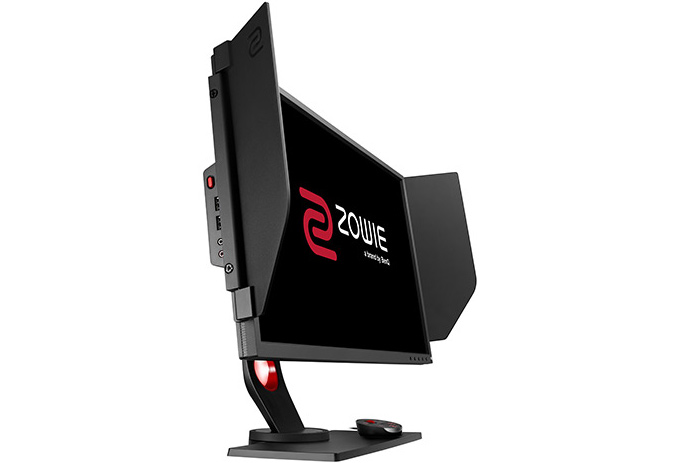
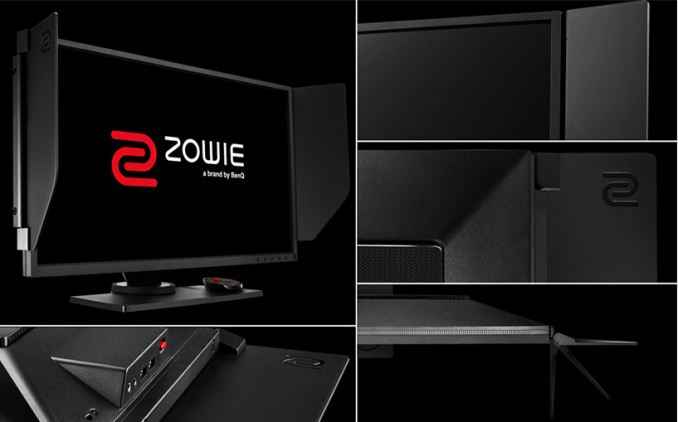
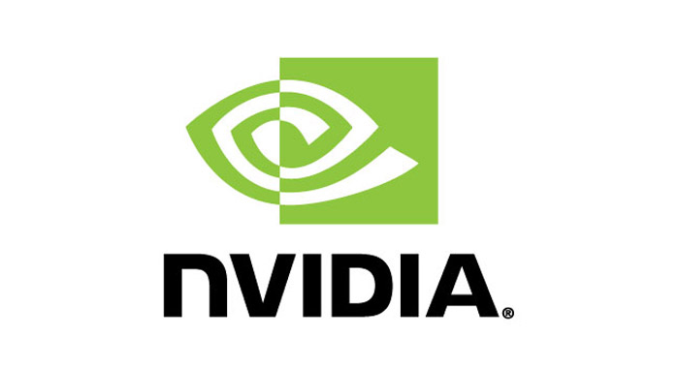
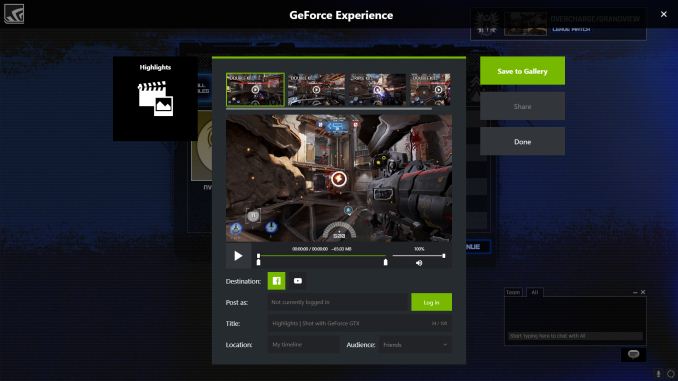
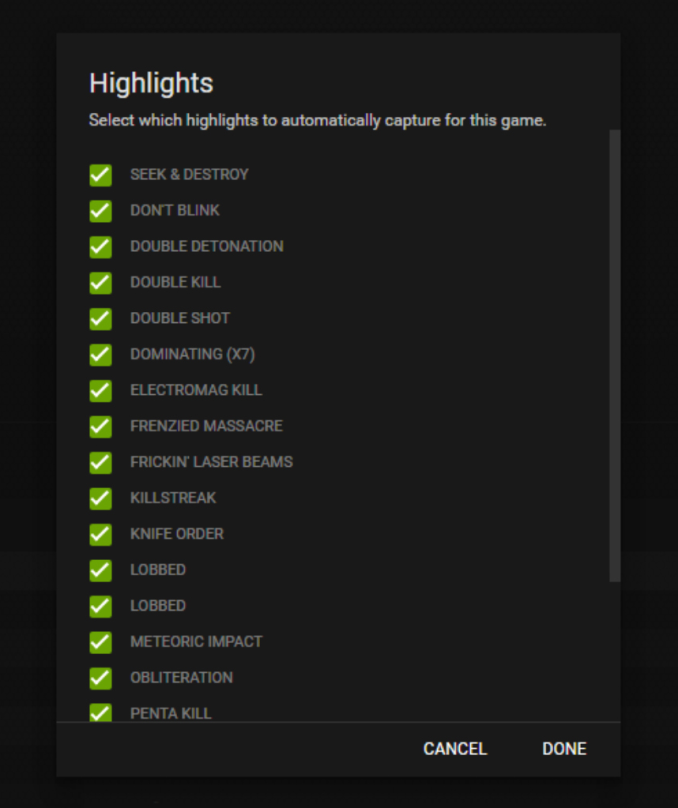
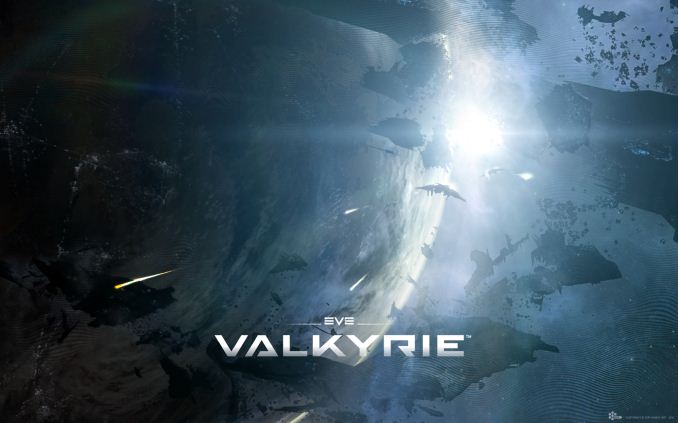
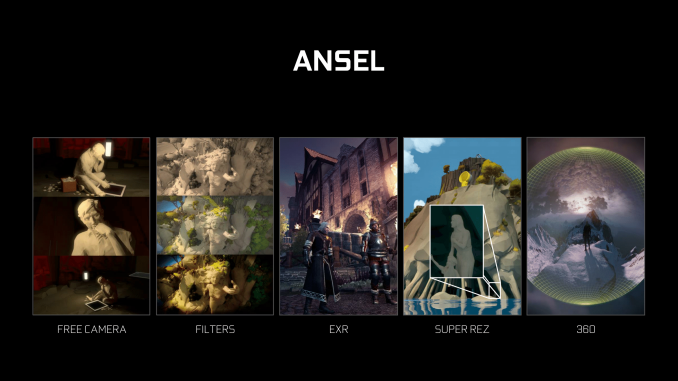

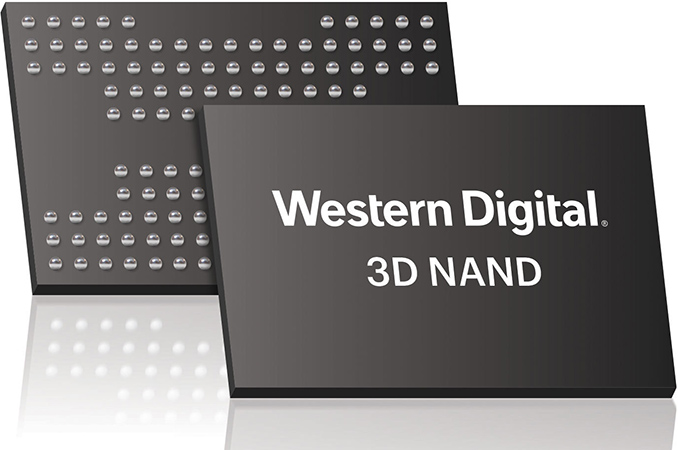



















Bookmarks